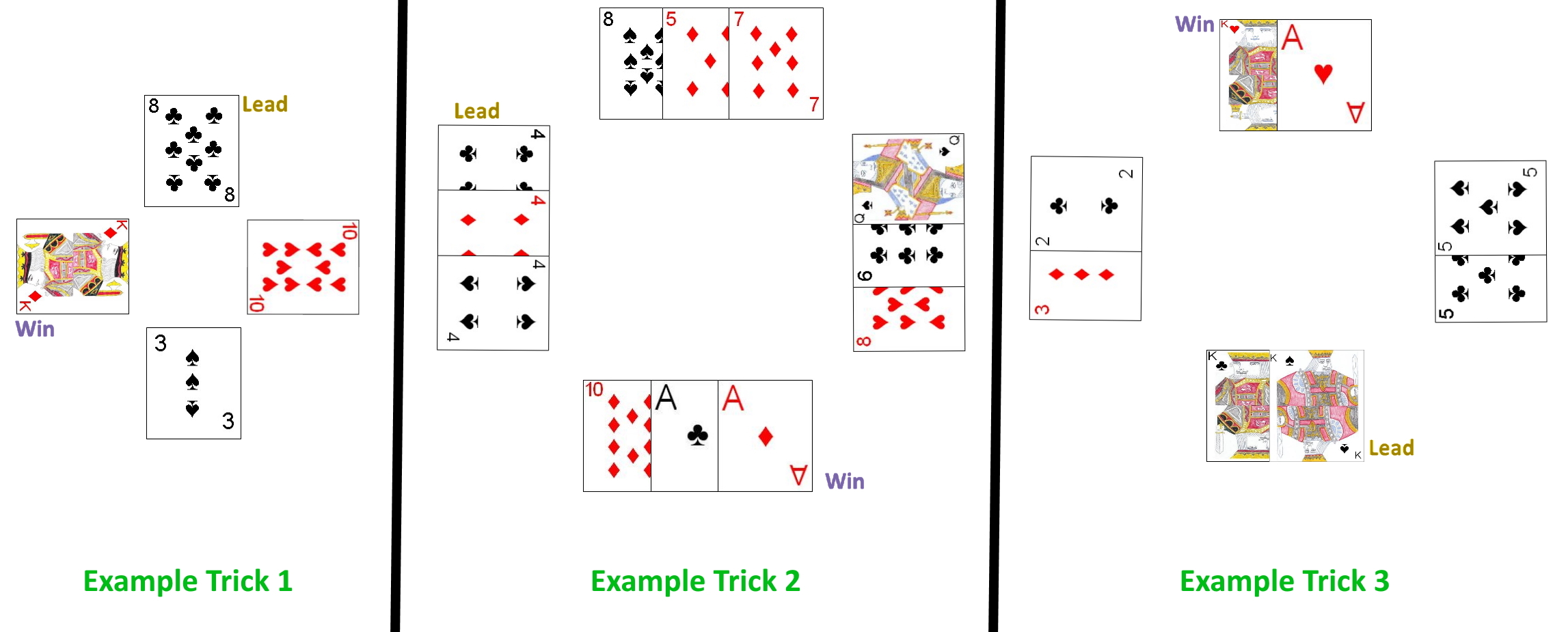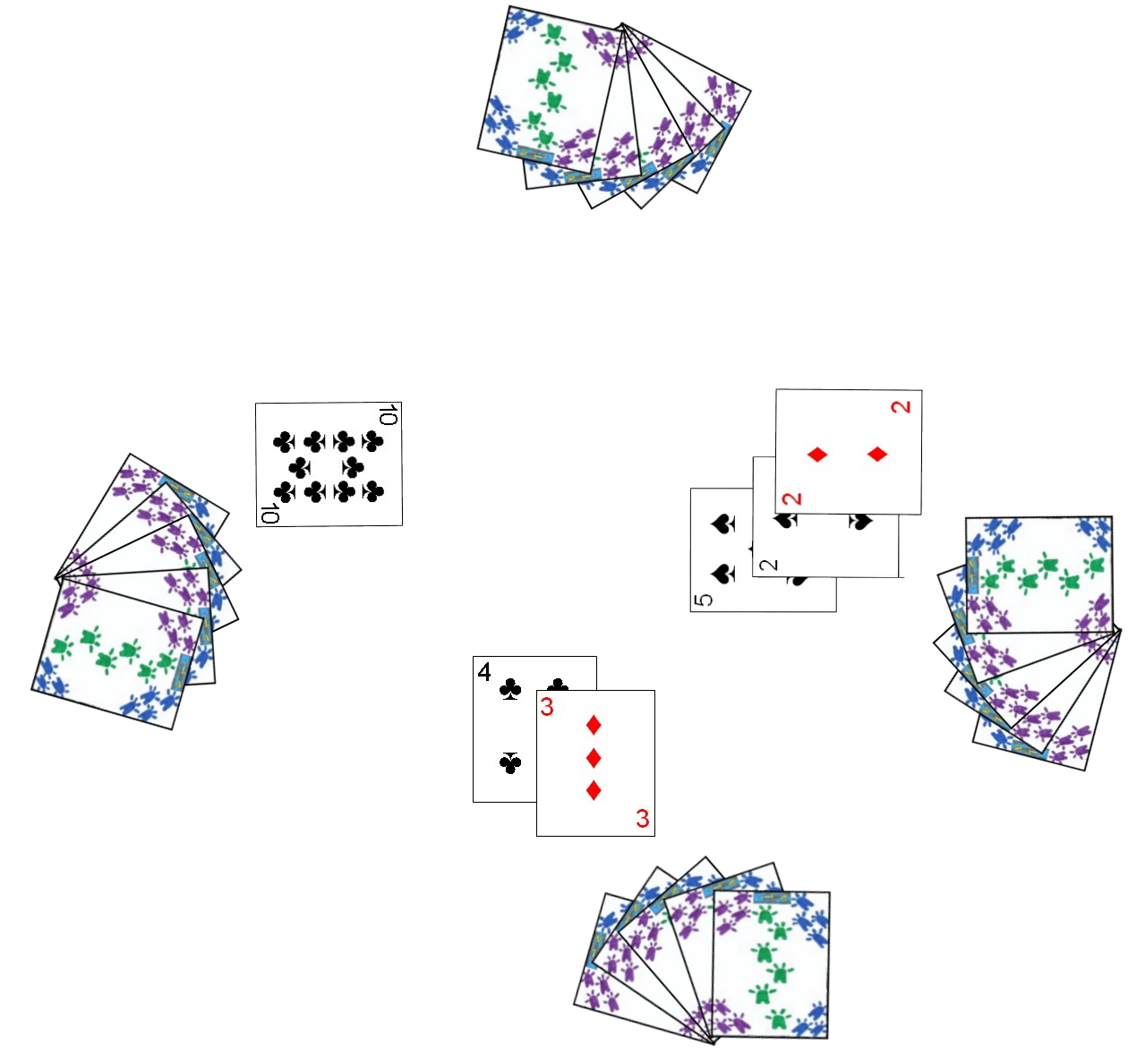Determination of seating positions and first dealer can be performed using a variety of methods, with draw for high card often the method of choice. In that method each player draws a card from the face-down shuffled deck. Any players drawing cards that are equal in rank to the card so drawn by another player must discard the card drawn and draw another card, continuing to do this until drawing a uniquely ranked card. The players seat themselves at the table in the order of cards drawn. The player drawing the highest card of all is designated the first dealer. After the first hand, the loser of the previous hand is set as the dealer for the next hand.
Once the players are seated, the dealer for the hand should thoroughly shuffle the deck and offers it to the player at his immediate right for the cut. After the cut, the dealer then begins distributing the cards around the table, one by one and face-down, starting with the player at his immediate right and continuing in a clockwise rotation around the table. On the first hand, the dealer distributes exactly seven cards to each player in this way. On each subsequent hand, the specific card played by the losing player on the last trick of the game determines the number of cards dealt on the next hand (see below). He places the remainder of the deck on the table, for use in any card exchanges.
 After the dealer has distributed the requisite number of cards for the hand, each player picks up his hand. Before play begins, a round of card exchanges begins. Starting with the player to the immediate left of the dealer and continuing in a clockwise rotation around the table, the players have the opportunity to exchange cards from the hand for new ones dealt from the remaining pack of undealt cards. Thus, the player may discard any number of cards from his hand face down to the side (out of play) and receive an equal number of replacement cards in exchange. This continues from player to player around the table. However, if the deck runs out of cards, a player may only exchange for whatever cards are left in the deck, and subsequent players (if any) may not exchange any cards and must retain all the original cards as dealt. A player may exchange all, some, or none of the cards from his hand, as long as there are enough cards remaining in the undealt pack.
After the dealer has distributed the requisite number of cards for the hand, each player picks up his hand. Before play begins, a round of card exchanges begins. Starting with the player to the immediate left of the dealer and continuing in a clockwise rotation around the table, the players have the opportunity to exchange cards from the hand for new ones dealt from the remaining pack of undealt cards. Thus, the player may discard any number of cards from his hand face down to the side (out of play) and receive an equal number of replacement cards in exchange. This continues from player to player around the table. However, if the deck runs out of cards, a player may only exchange for whatever cards are left in the deck, and subsequent players (if any) may not exchange any cards and must retain all the original cards as dealt. A player may exchange all, some, or none of the cards from his hand, as long as there are enough cards remaining in the undealt pack.
Once the round of card exchanges has completed, play of the hand begins, with the player to the immediate left of the dealer playing the first card or cards to the first trick.
The leader to the trick may play any card from his hand face-up to the table to start this trick. However, unlike in most trick taking card games, the leader to the trick may play multiple cards to start the trick, but all cards led must be of the same denomination (for example, the leader may lead two Kings to a trick). One additional restriction is that, because the last trick will always consist of exact one card, the leader to a trick, if holding two or more cards in hand, must leave at least one card in his hand for the last trick of the hand. After the leader plays one or more cards to the trick, each other player, in a clockwise rotation around the table must then play an equal number of cards to the trick. If a player is able to beat the current highest play to the trick he may do this (but is not required to). To beat a single card played, the player must play a card of the same or higher denomination (of any suit, as suits do not matter in this game). If multiple cards were played, the player must play an equal number of cards, but must play a card higher or equal to each of those cards. If a player is unable to (or elects not to) beat the current highest previous play to the trick, he must play a number of cards equal to those originally led to the trick, but these must be his lowest cards remaining in his hand.
After each player has played to the trick (all playing the same number of cards), it is determined which player was able to win the trick. As mentioned, each player must either beat the highest current play to that trick, or if unable to do this, must play his lowest cards. Thus, the last player to play a higher (or equal combination) is said to win the trick. All the cards played to the trick are set aside, out of play. The winner of the trick, then leads the first card (or cards) to the next trick.
The game continues until the second to last trick, in which each player should then have one card remaining in the hand. After that second to last trick is played, the players all place their last card on the table. The player with the highest last card remaining loses the hand, and earns a number of penalty points based on the denomination of that last card. The following chart shows these penalty points as earned by that player for this last card:
| Card Denomination | Penalty Point Value |
|---|---|
| Ace | 11 |
| King, Queen, Jack | 10 Each |
| 2, 3, 4, 5, 6, 7, 8, 9, 10 | Value as marked on card |
 This last card is left face-up in front of the losing player for the remainder of the game, which also assists in scorekeeping,
allowing every player to see the score of every other player at a glance. Thus, on each subsequent hand during the game, the losing card will no longer be added to the deck. if two or more players tie for the highest card, these player each earn these penalty points, leaving that point scoring card face-up in front of themselves on the table for the remainder of the game.
This last card is left face-up in front of the losing player for the remainder of the game, which also assists in scorekeeping,
allowing every player to see the score of every other player at a glance. Thus, on each subsequent hand during the game, the losing card will no longer be added to the deck. if two or more players tie for the highest card, these player each earn these penalty points, leaving that point scoring card face-up in front of themselves on the table for the remainder of the game.
At any time a players accumulated total equals or exceeds 22 points, the player is eliminated from the game. While that player is still required to deal the next hand, he takes no other part in play.
Not only is the losing player of each hand required to deal the next hand, but the denomination of his card determines the number of cards dealt to each player during the next hand. Thus, the number of cards dealt to each player on the next hand is equal to the number of penalty points the loser earned on that previous hand. If there are not enough cards in the deck to deal out that number of cards to the players, the dealer would simply deal out the maximum number of cards he can from the deck to ensure each player would still receive the same number of cards.
As the game progresses, and players reach or exceed 22 points, they will, by necessity, drop from the game. The game continues until there is only one player remaining. If all the remaining players are eliminated (reaching or exceeding 22 points) on the same hand, the player with the lowest score of these players is considered the winner.